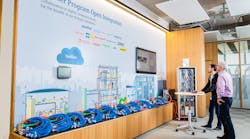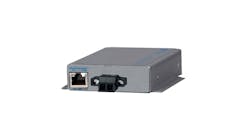In a further boost to applying Ethernet in intrinsically safe (IS) locations, Endress+Hauser reported March 30 that it just conducted two successful load tests of a realistic Ethernet-APL setup at its headquarters in Reinach, Switzerland. The tests were designed with end-user specifications from BASF and hardware from ABB, Endress+Hauser, Honeywell and Pepperl+Fuchs. Together, they report the tests demonstrated that components from different manufacturers can combine to create a reliable, robust Ethernet-APL system.
The first test involved nearly 240 Endress+Hauser measuring devices, including flow, pressure, temperature and level sensors. They were networked via Ethernet-APL and Profinet with Pepperl+Fuchs’ field switches and Honeywell’s control system. The second test used ABB’s control system, and tested it along with the field switches and measuring devices used in the first test (Figure 1).
Endress+Hauser reports the result of both tests showed that Ethernet-APL could be used in realistic circumstances. This is because the tests were carried out with a maximum-sized network layout, and Endress+Hauser adds the scalability and fault tolerance of the devices, controllers and network were successfully verified. It also states that all relevant requirements, such as total netload or redundancy switchover times, were met or exceeded.
“The load tests proved that Ethernet-APL can be used for real. The components from various manufacturers work together smoothly, and the systems run reliably,” says Jörg Reinkensmeier, head of the Open Integration partner program at Endress+Hauser, whose supplier members supported the tests. “We’re proud that the close cooperation with our Open Integration partners made it possible to validate this technology. We’ve reached the milestone of bringing Ethernet to the field level of process automation.”
Assist other architectures
Tim Shope, VP of digital transformation solutions at Endress+Hauser, adds that, “Ethernet-APL will be an enabler to the Open Process Automation Standard’s (O-PAS) vision of connecting field devices and getting more data than is available via 4-20 mA and HART. It also extends and builds on the physical Ethernet architecture via protocols like Profinet, Modbus-TCP and EtherNet/IP,” says Shope. “Once we get these protocols on Ethernet-APL, we’ll be able to communicate and interoperate via switches.
Shope reports that Endress+Hauser plans to roll out three protocols on Ethernet-APL over the next two years. These include Profinet, Modbus TCP/IP and EtherNet/IP. These connections and Ethernet-APL’s extended reach will allow process industry users to take advantage of Ethernet’s pervasiveness as its experienced in the mainstream IT, business and consumer realms.
“Many people use Ethernet via the Internet frequently for tasks like shopping online. Ethernet-APL gets us closer to that level, so instruments can have a better chance of telling us what’s wrong,” says Shope. “For example, we tied our Netilion Health condition monitor via a REST API to cloud-based CMMS data, which allowed the device order parts and services to fix them. As Ethernet-APL gets more prevalent, users will be able to access production data in their field instruments and check the health of those devices without going through the usual I/O and control system.”
“Ethernet-APL also opens a lot of potential opportunities for interoperability between intelligent field devices with a common interface. If one device talks EtherNet/IP and another talks Profinet, they’ll still need a gateway to translate, which could mean added time and labor for configuration and programming. However, even these tasks are getting easier because organizations like ODVA are working on templates to unify the integration that harmonizes Profibus, EtherNet/IP and other protocols. These profiles enable an Endress+Hauser flowmeter to appear the same on the network as another manufacturer’s flowmeter and gives us the interoperability we need.”





